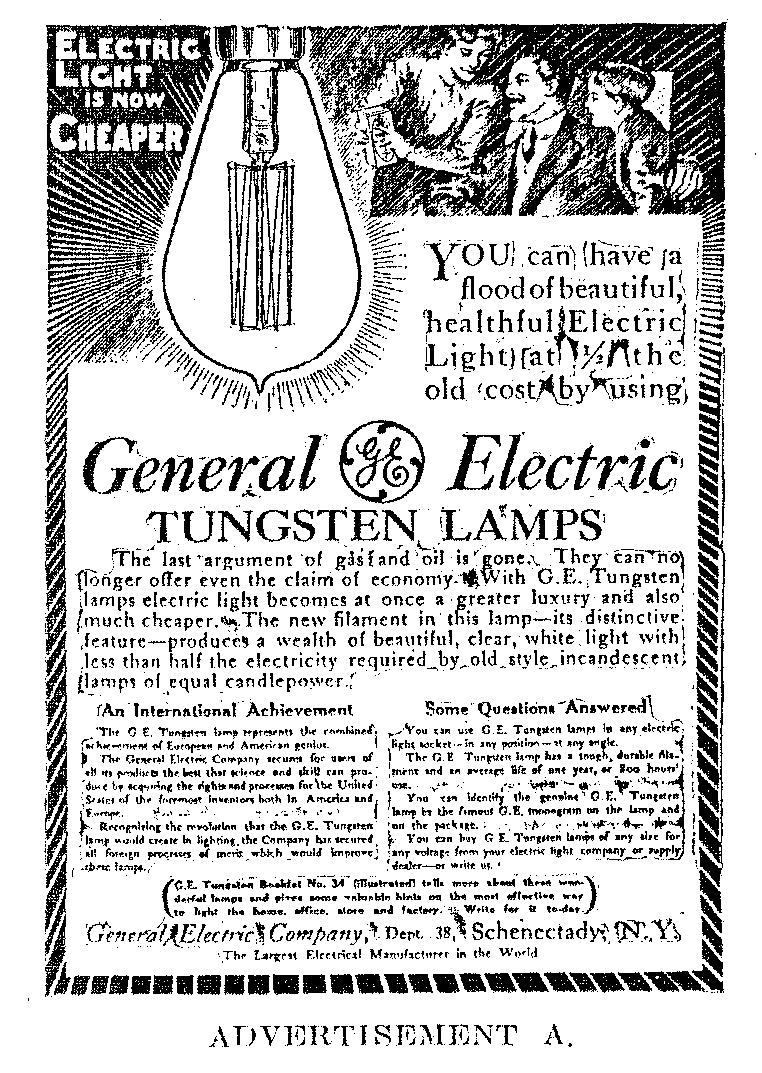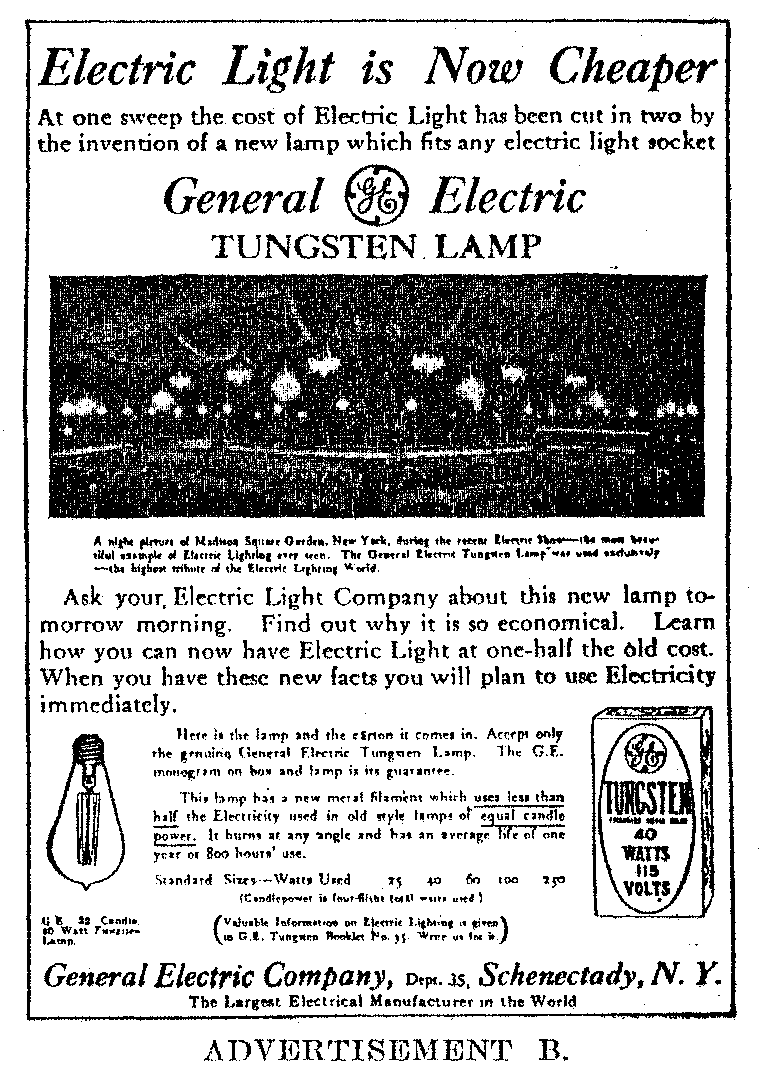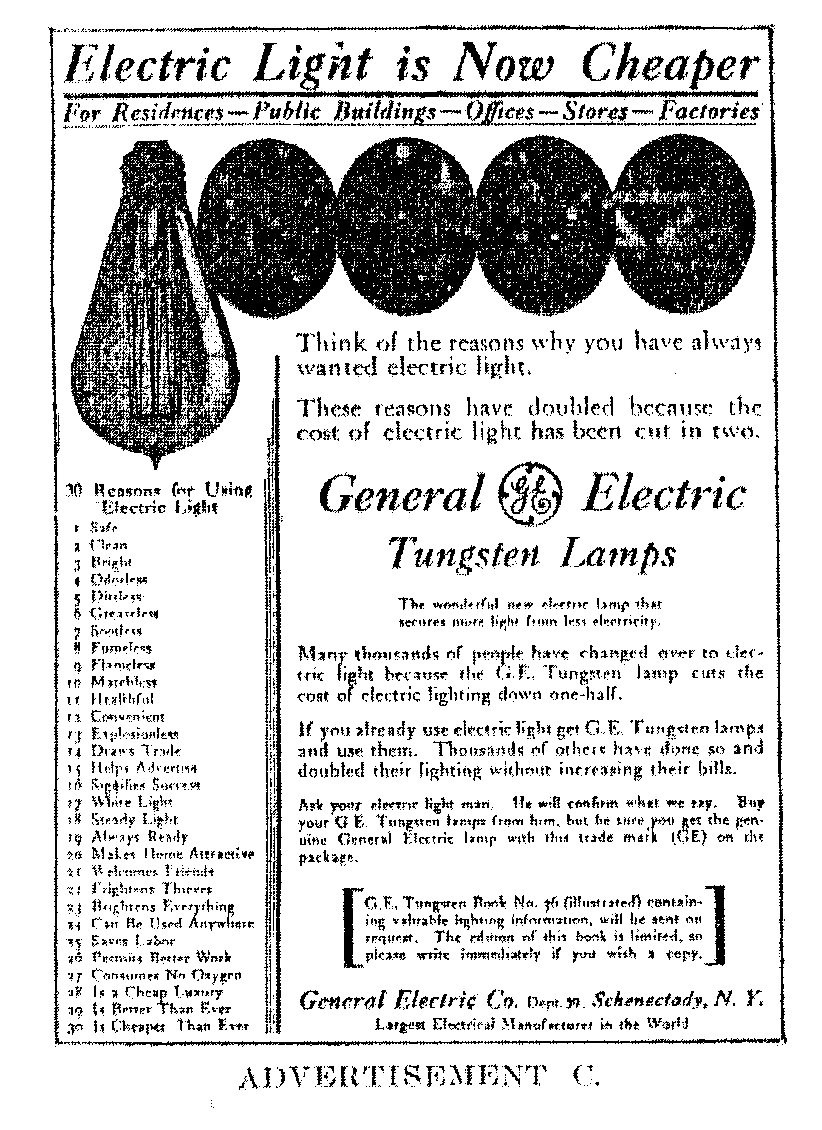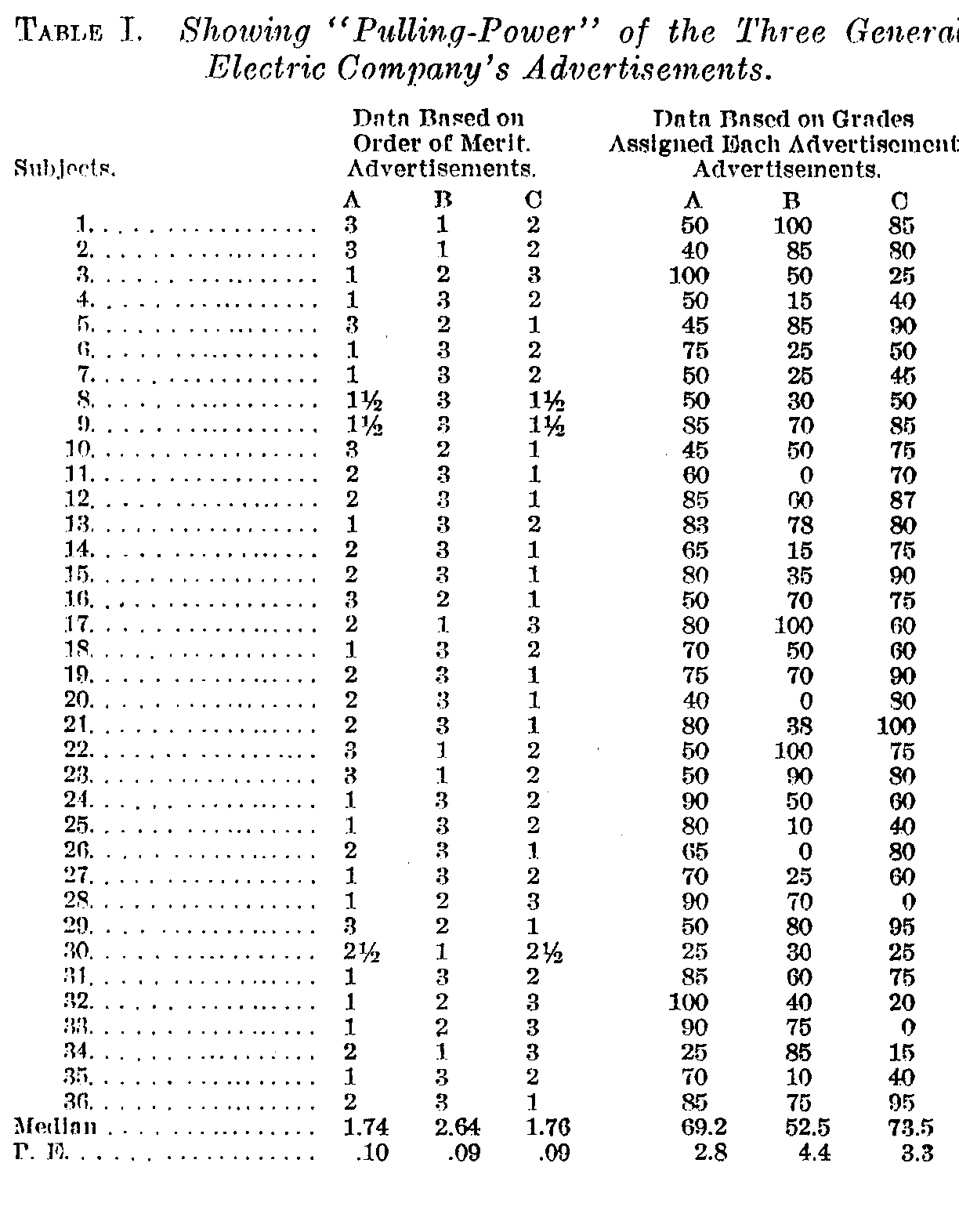Psychological Methods As Applied To Advertising
EDWARD K. STRONG, Jr.,
Columbia University.
The application of psychological laboratory methods to advertising problems has a twofold purport. It is of value to advertising and to psychology. For if the relative value of each advertisement in a set may be determined accurately before it has been used, then much waste may be eliminated by simply not using the poorer advertisements of the set. At the present time there is no way of estimating which are the good and which are the poor advertisements except on the basis of personal judgment; and when the reviews and criticisms of different advertising men are compared, it is apparent that this personal judgment is today a very variable factor. But this phase of the question is less interesting to, the readers of this JOURNAL than the other one, i.e., the value of such work to psychology itself.
The greater part of the experimental work that has been clone in psychology has been under the influence of the more or less conscious ideal that we must understand the simple mental processes first, and then build up to the complex from this basis by combining known simple processes. With no thought of criticizing this ideal, it is well, however, to face the situation that it is going to be a very long time before, by such a procedure, an analysis can be made as to why A buys Crisco in response to the advertisements which have appeared during the last year. In the field of aesthetics we have a similar situation. The "simple" forms, such as squares, rectangles, circles, ellipses, etc.' were studied. And then the experimenting practically stopped, for the problem of building from these up to a work of art was too vast to be dealt with. (Of course, general principles have been developed in the study of the
(394) simple which have been carried over and applied to the complex, but, strictly speaking, there has been no extended attempt to build up from the simple to the complex.)
Moreover, me must ask whether a square and an ellipse really are simpler psychologically than a simple (that is, uncomplicated) photo or drawing. An immediate response can he made to either ellipse or photo as to whether they are pleasing or not. Both can be "grasped" in one glance and can be reproduced or identified later. It is true that more details will he lacking in the reproduction of the simple photo than of the ellipse, but, on the other hand, it can be more definitely identified later on than can the ellipse. Simpson[1] reports that hit 42 per cent. of 25 simple forms could be identified by his group of 17 "good" subjects and 18 per cent. by his "poor" subjects while 73 per cent. of 25 advertisements can be identified by college students, who were of less ability than his 'good group [2] is there any reason, then, why complex physical materiel may not be used as well as simple physical material is the stimulus for experimental work? Are we justified in declaring the latter produces simple psychical reactions, whereas the former does not, or even that the latter produces simpler reactions than the former? And in any case, is it not worth while to know what the human mind will do in its response to a complex physical stimulus?
With these thoughts in mind the following experiment, made with complex physical material, is presented as showing that Snell material is consistently reacted to, and that experimental methods can now foretell which advertisement will influence, the most individuals.
From a psychological standpoint there are two main problems to he considered in evaluating any advertisement. The advertisements mist, first of all, attract attention. Unless it is noticed by the reader it has no value at all. It must, secondly, create a desire for the advertised commodity. Some advertisements have good "attention-value," in that they at-tract attention to themselves, but they do not influence the
(395) reader toward buying—they lack "pulling-power." "In making any study of advertisements both of these factors must be considered.
Our experience, based on experiment and introspection, has . shown that the two factors—attracting attention and creating desire—must be considered separately. By this it is not meant that the two factors are separate and distinct, and that they each depend on different features of the advertisement—an error into which the bulk of advertising writers have fallen—but that they depend on two different attitudes of the reader. When studying the first factor we must have our subject in it, passive attitude toward the material before him and then determine what advertisements catch his attention, i.. e., arouse him so that he stops and looks at them, in contradistinction to the remaining advertisements. Psychologically stated, we have involved here the factors of perception and passive or primary attention. But when studying the second factor—that of creating desire—we have to have our subject in in active attitude. At least, we do have him in such a condition as soon as the experiment is started. And because that is so, we cannot then determine which advertisements would have attracted him while in a passive "don't-care" attitude. It is because of this situation that the two separate tests—one for "attention-value" and the other for "pulling-power"—have been developed.
A concrete example will make this matter clearer. Mr. F. R. Davis of the General Electric Co. supplied the writer some-time ago with five tungsten lamp advertisements, .together with the detailed results that the company obtained from them. Only three of the five will be considered here, as the other two were quite different in one respect from these three. This difference so noticeably affected the company's data that no real comparison can he made between the actual returns of the two advertisements and those of the three. For the sake of simplicity, therefore, the two will not be used here.
The relative attention-value of the three advertisements can be expressed by the following figures:
(396)
Advertisement A, attention-value 1.88 P. E. 0.17
B,
1.80 P. E. 0.16
C,
2.25 P. E. 0.14
The figures represent the relative order of effectiveness in attracting attention. If A had been first in every case, it would have been ranked "1.00"; if B had been second in every case, it would have been ranked "2.00," and if C had been third in every case, it would have been ranked "3.00." But the three advertisements did not have these three positions in every case. A and B are practically tied at 1.8, and C stands at 2.3. The probable errors (P. E.) indicate that there is no true difference between A and B, but that both are decidedly superior to C.
The method used in obtaining these results was as follows : The advertisements were laid face up on a table in such a way

(397)

that they were hidden from the subject by a screen. It was explained to the subject that there were three advertisements on the table, and that in a moment the screen would be re-moved; that he was to take one general glance at all the advertisements and then to commence picking them up as fast as he could in the order in which they caught his attention. Two points were emphasized—first, that he was simply to glance at all the advertisements for only a moment; second, that he was then immediately to commence picking them up, and must continue doing so until they were all picked up. The order in which they were picked up was recorded. This order represented the relative order of "attention-value" of these advertisements for that individual. This order differs for different individuals; some orders so obtained are found to be nearly the reverse of other orders.
"Attention-value" depends on the relationship of the de-
(398) tails in an advertisement to the past experience of the reader. The firm name may have no attention-valve for 99 per cent. of readers, lint have tremendous attention-value for i per cent. simply because it is their firmly name. And so with other details. Ordinarily speaking;, an advertisement commands our attention because it has in it some detail or details that are familiar and interesting; in very exceptional cases, because it concerns a strikingly unknown object. No distinction is made in this test between attention-value depending upon relevant or irrelevant details in the advertisement. The former is, of course, superior, but I relieve the difference between the two is measured in the experiment on pulling-power, described below, and so need not concern us here.
Two precautions are always taken in this test. The advertisements are rotated in position on the table as they are suc-

(399) -cessively exposed, in order to equalize any difference due to position. Second, the advertisements are not shown to the subject before the experiment—they ire relatively unfamiliar to him at the time of the test.[3]
From the order in which the advertisements were bricked up by the various subjects in average or median may be readily obtained. This central tendency represents the final finding of the test. Medians seem much preferable to averages in this work, and are used here. They are expressed in the figures above.
Having obtained the relative "attention-value," the next step was to determine the relative convincingness or "pilling-power" of the advertisements. The directions, as employed in the test with the General Electric Co. advertisements were as follows:
"Arrange these advertisements in the order in which you would buy the Tungsten limps. Take for granted that each advertisement represents a different make of lamp that: is, one is a Western Electric, one a General Electric, etc."
The second paragraph heads off a great many questions, and was used simply and solely for that purpose. In other words, it makes tale work more natural and real. When the arrangement was completed, the second part of the directions was presented to the subject. It was is follows:
"When you have completed your arrangement, give each advertisement a grade on a scale from 100 to 0. 100 should represent that grade you would give an advertisement which appeals so strongly as to irresistibly force you to buy the article. 0 should represent that grade you would give an. advertisement that had no appeal for you at all, i.e., had no effect on you."
(400)
This grading of the advertisements was first adopted in order to gain some idea of whether the advertisements did or did not appeal to the subject, and also the amount of difference in the appeals of each separate advertisement. The writer has found that the data-from these grades can be used as instructively as the data from the arrangements. Advertisements that are distasteful or antagonistic, or that prejudice

(401) one against the advertised article, are, of course, to be graded below 0. Very few such cases occur with men, but they are quite frequent with women.
In a good many cases the subject will revise his order of arrangement when forced to grade the advertisements. The revised order is preferable, because the act of grading the advertisements seemingly forces greater concentration upon the work, and the subject tends to forget that it is only an experiment and to act more as he would if actually confronted with the situation.[4]
Table I presents the results from 36 subjects respecting the' relative "pulling-power" or persuasiveness of the three General Electric advertisements. The individual results are given, as they afford an opportunity to compare the data from. the two separate methods of measuring "pulling-power." The first three columns of the table give the respective orders of arrangement of the 36 subjects, and the last three columns give the respective ratings of the same subjects. Subjects 1. to 24 are men, and 25 to 36 are women. The medians of the six columns are given together, with their probable errors. From the medians of the first three columns we must conclude that advertisements A and C are about equal in value, with the advantage in favor of A, and that B is very much inferior to the other two. From the medians of the last three columns we likewise must conclude that A and C are about equal in value, but that here the advantage is reversed, being somewhat in favor of C. B is here again decidedly inferior to the other two. (The two systems of recording results are sometimes puzzling to the uninitiated. But if it is borne in mind that in the first three columns—where an order of merit is obtained--the smaller the figure the better is the advertisement, because it is ranked more nearly first, i., c., "1.00," and that in the last three columns where a percentage of perfection is recorded—the larger the figure, the better is the advertisement, because it is ranked then more nearly 100 per cent., the meaning of the figures will be clear.) We should conclude from the two sets
(402) of data that advertisements A and C are practically equal in "pulling-power," while B is decidedly inferior. We now have the following results:
Advertisements A and B are equal in "attention-value"; C is inferior.
Advertisements A and C are equal in "pulling-power"; B is inferior.
We must undoubtedly conclude, then, that A is the most efficient of the three. How to equate the outer two properly is still unknown. The relationship of the "attention-value" test to the "pulling-power" test can only be solved after much more work has been done. At present the indications front a number of tests lead the writer to place very much more emphasis upon the "pulling-power" than upon the "attention-value" test. We would then conclude in this particular case that C is only a little less efficient than. A, while B is considerably inferior. In other words, he follows the "pulling-power" test and modifies its results only slightly in accordance with the results of the "attention-value" test. (The "pulling-power" test will ordinarily correlate very highly with the actual results, while the "attention-value" test does not necessarily show high correlation.)
The actual results from these three advertisements as supplied by Mr. F. R. Davis of the General Electric Co. show that advertisements A and C were about equal in value, although A was the superior of the two, and that both advertisements were very much superior to B. Efficiency ratios of the three advertisements in terms of A. were as follows : 1.00 for A, .52 for B and .93 for C.
These experiments show, then, an order of efficiency of the three advertisements and give some idea as to the amount of difference in efficiency between the various advertisements. This order of efficiency agrees with the order obtained in actual business. All the experiments so far conducted have resulted in quite close agreement between the experimental results and the business returns.
What we need now is methods which will give not simply in order of merit, but some fairly definite idea as to the amount of business each advertisement will bring in terms
(403) of any one of them. The methods of grading advertisement after they have been arranged in an order of merit (see the second three columns of Table -1.) appears to be a step in this desire(] direction. If the medians—69.2 for A, 52.5 for B and 73.5 for C—are divided by 69.2 to reduce them all to ratios in terms of A, Ave have the following ratios: 100 for A, 76 for B and 106 for C.[5]
These ratios do not agree very closely with those supplied by the General Electric Co. But the experimental ratios are only based on the "pulling-power" factor, and do not take into account the "attention-value" factor. The poor "attention-value" of C would bring down the ratio as given above, making the experimental ratio more near]), in accord with the actual ratio; but, on the other hand, the good "attention-value" of B would raise the experimental ratio, making it still higher than the actual value would lead its to expect.
What we have obtained in this experiment is this : We have determined experimentally that advertisements A and C are about equal in efficiency, with the advantage in favor of A, and we have determined that B is very much inferior. Our knowledge of the results obtained from these advertisements in actual business shows that our analysis is correct. Our attempt, however, to state the experimental findings in efficiency ratios has not been so accurate as we should like. Further work must be done before we, can be confident of such results. Nevertheless, the grades do point out clearly that A and C are about equal, and that 13 is very much less efficient, which is the actual situation.
No attempt was made in this particular experiment to determine why A and C were about equal in creating desire for the lamps and why B was, inferior to them in this respect. 'I'll(, why is a- different problem from the ?drat, and seemingly much more difficult to handle.[6]
(404)
Introspection has often given very valuable hints as to the why, and the writer employs it ordinarily in all his work. But at best, he has never felt that it gave more than' simple suggestions as to the real cause of the subject's attitude to-ward the advertisement. In the vast majority of cases nothing of value has been obtained and no true introspections appeared. Well-trained psychologists, who emphasize introspection in their writings, when acting as subjects for the writer have failed in this case to give introspections which they considered of any value at all.
A good many psychologists hold that the work represented in this
article is not psychological, in that it does not analyze the mental processes
involved. The writer feels that, if this is the case, Ebbinghaus' study of the
fading of memory also cannot be deemed psychological, as it gives only the
results of mental processes, but does not explain them. But surely the facts
concerning memory given us by Ebbinghaus in his curve have been of tremendous
value in later analyses of the process itself. Is not the situation the same
here? When once we know that A is superior to B, then we can
intelligently attempt to explain the cause; but before we know this result of
mental work we cannot attempt an explanation of causes of any sort. itis with
this idea in mind that the writer holds to the belief that what has been
presented is within the psychological realm. But it is only one step toward a
complete understanding of the whole situation, and many more steps are necessary
before the end can be reached.